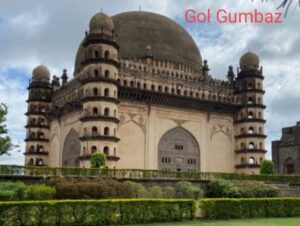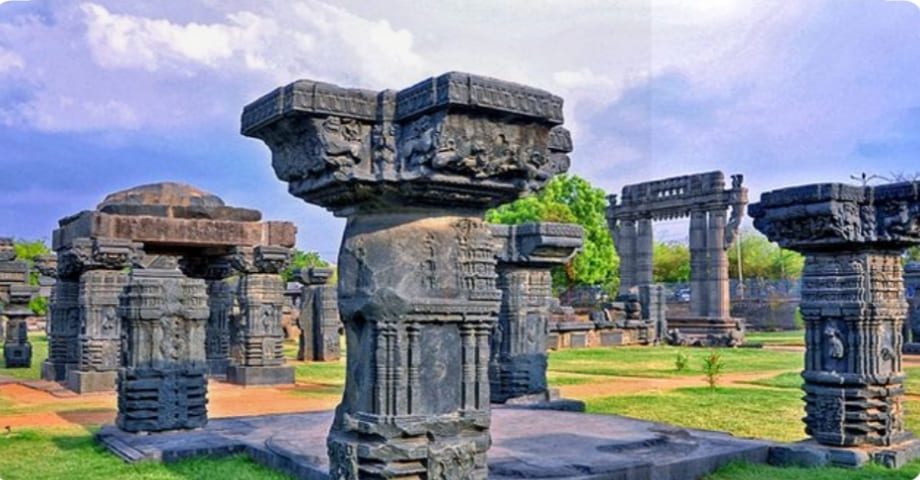Gol Gumbaz, located in Bijapur (now known as Vijayapura), Karnataka, is one of the most iconic monuments of India. Renowned for its massive dome and intricate Indo-Islamic architecture, it has attracted tourists, historians, and architects for centuries. This awe-inspiring structure, with its mesmerizing acoustic features and historical significance, holds a special place in the annals of Indian architecture. In this blog post, we will explore the history, architecture, unique features, and tourism prospects surrounding Gol Gumbaz, offering a comprehensive view of this magnificent monument.

1.Gol Gumbaz: History of Gol Gumbaz
Gol Gumbaz, which means “Round Dome” in Persian, was built in 1656 as the mausoleum of Muhammad Adil Shah, the seventh Sultan of the Adil Shahi dynasty, who ruled the Deccan Sultanate in the 17th century. Adil Shah was known for his love for art and architecture, and Gol Gumbaz stands as a testament to his desire for grandeur.
The construction of Gol Gumbaz took over 20 years, and it remains one of the largest domed structures in the world. The architect, Yaqut of Dabul, employed a blend of Dravidian and Islamic styles, showcasing the cultural confluence prevalent during the time. The monument was designed as a tomb that would reflect the magnificence of Adil Shah’s reign and the architectural prowess of the Adil Shahi dynasty.
2.Architectural Significance of Gol Gumbaz
Gol Gumbaz is celebrated for its architectural brilliance, particularly its massive dome, which is one of the largest unsupported domes in the world. Measuring 44 meters in diameter, it rivals some of the most famous domes globally, such as St. Peter’s Basilica in Rome. The symmetrical design of Gol Gumbaz is a fine example of Indo-Islamic architecture, blending local influences with Persian design elements.
The entire structure sits on a raised platform with four imposing minarets, each rising to a height of 51 meters. The minarets are octagonal and consist of seven storeys, offering panoramic views of Bijapur from the top. The central dome is supported by a square chamber measuring 47.5 meters on each side. The chamber houses the tombs of Muhammad Adil Shah, his family members, and his court members.
3.Unique Features of Gol Gumbaz
One of the most striking features of Gol Gumbaz is its incredible acoustic system. The central chamber, known as the “Whispering Gallery”, has the ability to echo sound up to seven times. Even the softest whisper made on one side of the chamber can be clearly heard on the opposite side, creating a mesmerizing auditory experience. This phenomenon is due to the dome’s unique construction, where sound waves are reflected in such a way that they travel across the chamber without significant loss of intensity.
Another significant aspect of Gol Gumbaz is the sheer size of the dome and its ability to stand without external support. This engineering feat was accomplished by using thick walls, intricate vaults, and a system of internal arches to bear the dome’s immense weight. The simplicity of the structure, with minimal ornamentation, highlights the grandeur of its scale and the precision of its engineering.
The mausoleum also contains an underground vault where the actual graves are located. The tombs on the upper floor are symbolic, while the real burial chamber is below, adding an air of mystique to the structure.

4.Gol Gumbaz: A Symbol of Power and Prestige
Gol Gumbaz was not just a tomb; it was a statement of power, grandeur, and prestige. Adil Shah wanted to leave behind a legacy that would immortalize his reign, and Gol Gumbaz fulfilled that vision. Its sheer size, complexity, and aesthetic appeal were designed to convey the sultan’s might and the wealth of his kingdom.
Moreover, the monument stands as a symbol of the cultural synthesis that occurred in South India during the reign of the Deccan sultanates. The Adil Shahi rulers were great patrons of art, architecture, and culture, and Gol Gumbaz embodies their contributions to the architectural heritage of India.
5.Tourism and Gol Gumbaz Today
Today, Gol Gumbaz is one of the most popular tourist destinations in Karnataka. Its historical importance, coupled with its architectural beauty, attracts thousands of visitors annually. The Archaeological Survey of India (ASI) has taken measures to preserve and maintain the monument, ensuring that its grandeur is intact for future generations.
Visitors are often captivated by the echoing acoustics of the Whispering Gallery and the sheer size of the dome. The view from the minarets offers a glimpse into the past, showcasing the old city of Bijapur, with its many historical monuments dotting the landscape.
For history buffs and architecture enthusiasts, Gol Gumbaz is a must-visit. The monument provides a deep insight into the architectural styles of the Deccan Sultanate and offers a tangible connection to the bygone era of Indo-Islamic grandeur. The peaceful gardens surrounding the monument provide a tranquil setting for visitors to relax and reflect on the significance of the site.
6.How to Reach Gol Gumbaz
Bijapur, now Vijayapura, is well-connected by road and rail networks, making it easily accessible from major cities like Bengaluru, Pune, and Hyderabad. The nearest airport is in Belgaum, which is around 205 kilometers from Bijapur.
Once in Bijapur, local transport options such as auto-rickshaws and taxis are available to reach Gol Gumbaz. It is advisable to visit early in the morning or late in the afternoon to avoid the midday heat, as the region experiences high temperatures during the day.
Conclusion:
Gol Gumbaz stands as a towering monument of India’s rich architectural heritage. Its historical significance, engineering marvels, and aesthetic beauty make it one of the most remarkable structures in the world. The Gol Gumbaz is more than just a mausoleum—it is a symbol of the Deccan Sultanate’s architectural genius and a lasting testament to the grandeur of the Adil Shahi dynasty.
Whether you are an architecture enthusiast, a history buff, or a traveler seeking to explore the lesser-known gems of India, Gol Gumbaz offers a unique and enriching experience. The echoes of its past continue to resonate through the whispering gallery, reminding us of the magnificence of an era gone by. Visiting Gol Gumbaz is not just a journey through history but an exploration of human ingenuity and artistic excellence.
Plan your visit to this architectural wonder, and immerse yourself in the splendor of Gol Gumbaz, one of India’s most breathtaking landmarks.
FAQ:
1.What is Gol Gumbaz famous for?
2.What is the secret of Gol Gumbaz?
3.Who completed the construction of Gol Gumbaz?
4.Gol Gumbaz is located in which state
5.Gol Gumbaz photos
6.Gol Gumbaz is the tomb of
7.Why is Gol Gumbaz famous
8.Gol Gumbaz historical importance
9.Gol Gumbaz is located in which district

